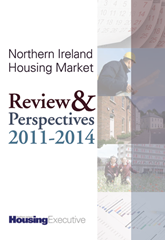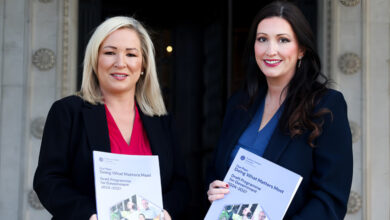The state of the sector
 agendaNi reviews the main trends identified by the Housing Executive’s research.
agendaNi reviews the main trends identified by the Housing Executive’s research.
Northern Ireland’s housing stock is modernising, with unfit dwellings at an all-time low, but a fragile economy means few first-time buyers are entering the market.
These trends are identified in ‘Northern Ireland Housing Market Review & Perspectives’, published annually by the Housing Executive. Its current edition covers 2011-2014.
Rocked by the global economic crisis, Northern Ireland’s economy is weakened by an official 7.3 per cent unemployment rate (61,000 persons), but when all types of joblessness are considered, more than a third of the workforce is workless.
Spending cuts will aggravate the problem and lead to more dependence on benefits. Construction lost around 30,000 jobs in the recession, according to the Construction Employers Federation.
Demographics
The province’s population is expected to grow by 7 per cent over 2008-2018, from 1,775,000 to 1,896,000.
There were 204,500 single-person households in 2008 but 249,400 are anticipated in 2018 and 273,800 in 2023. This implies more new dwellings but with different designs i.e. smaller units and more supported housing to help older people live independently.
This growth has been driven by immigration (with many migrants travelling alone) and broken marriages and relationships, although the report also points to the increasing number of older people living alone.
Up to 2015, the Housing Executive expects that 2,500 new houses will be needed per year, but it emphasises that supply should not outstrip demand.
Stock
Private sector new builds reached 6,800 in 2009-2010. However, this contrasts with 14,000 four years ago. In the same year, housing associations started work on 1,838 new social housing units, against a ministerial target of 1,750.
Ensuring funding for new social housing is the Housing Executive’s most difficult challenge but the winter cold snap emphasised that existing stock should not be neglected. Good quality housing, in turn, can lead to better health, education and social cohesion.
The revised draft Regional Development Strategy anticipates a need for 11,150 new houses each year up to 2025; the previous estimate was 12,235.
Affordability
A peak-to-trough fall of 41 per cent in house prices left the average at £148,243 in 2010’s third quarter, back to 2005 levels. The previous meteoric rise resulted in 60 per cent of house prices at £201,000 or more in mid-2007, while 90 per cent were £151,000 or more. The highest average was £250,586 in 2007’s third quarter.
During the same period in 2010, 26 per cent of dwellings were priced under £100,000.
Housing is more affordable but negative equity, tight lending, joblessness and debt mean that demand has dwindled. House sales and purchases have reached an historic low, just under 11,000 for the 12 months up to September 2010, which compares to 27,200 for that period in 2005-2006.
Lenders now typically offer mortgages at 75 per cent loan-to-value ratios but stricter criteria and credit history checks mean that few potential applicants qualify. Returning confidence to the market is a key challenge for policy- makers and the private sector.
The proportion of owner-occupied dwellings appears to have “peaked for the foreseeable future” after falling from 66 per cent to 62 per cent over 2006- 2009.
Rental
Rapid growth in the private rented sector over 2006-2009 led to its stock reaching 125,000 houses (one in six). The proportion rose from 12 to 17 per cent. Private rented dwellings are slightly more likely to fail the Decent Homes standard but more likely to meet the Housing Health and Safety Rating.
Falling house prices have made investors more willing to invest in rental. Houses in multiple occupation (HMOs) will continue to be important for students, young professionals and migrant workers.
Social housing accounts for 16 per cent of total stock (116,000 dwellings). Of these, 15 per cent fail the Decent Homes test, mainly due to poor heating. More than half (56 per cent) of social housing households had incomes of under £10,400 per year.
Housing stress and the overall waiting list have both doubled over the last decade and peaked in March 2008. The March 2010 waiting list stood at 38,120 but sharply increased to 39,344 last September. Over the same period, applicants in housing stress rose from 19,716 to 20,513. The number of households presenting themselves as homeless rose to 18,664 in 2009-2010, up 3 per cent on 2008-2009.
As explained, the net stock model, used to calculate social housing need, indicates that 2,500 new units are needed each year over 2010-2016; this comprises 1,900 to meet population growth and a further 600 to clear up the backlog since 2001.
Condition
Housing unfitness stood at 2.4 per cent in 2009, down from 3.4 per cent three years previously. The number of unfit dwellings fell from 24,200 to 17,500. Unfit dwellings tend to be vacant (59 per cent) and built before 1919 (48 per cent), and unfitness remains higher in the countryside (a 4.1 per cent rate).
The share of stock failing the Decent Homes standard fell from 23 per cent in 2006 to 15 per cent in 2009, but a consistent 19 per cent failed the Housing Health and Safety Rating in both years. The average SAP rating for energy efficiency rose from 52 to 57 over the same period but rising energy prices pushed fuel poverty up from 34 per cent to 44 per cent of households.
Policy
The new Executive’s policy agenda is not yet finalised but decisions in London and Dublin will have a strong influence on the outcome.
George Osborne’s first Budget last June proposed changes in how local housing allowance (LHA) is calculated, designed to save £1.8 billion. Around 38,000 private tenants here currently have their housing benefit assessed on LHA and around £15 million in government support could be cut, resulting in tenants losing homes and landlords losing income.
The October Spending Review will cut Northern Ireland’s capital spending by 37-40 per cent and its resource spending by 7-8 per cent by 2015, depending on Treasury or DFP estimates.
Around €5 billion of Nama’s €80 billion assets are estimated to be located in Northern Ireland. Austerity and unemployment have left ‘ghost estates’ across the Republic.
Looking ahead, unemployment, tax increases and spending cuts will reduce household budgets in the UK. The Republic’s December 2010 Budget has reduced consumer confidence and spending and similar trends are expected north of the border.
A “very substantial” demand for social housing remains after the peak in waiting lists and housing stress. A major increase in new housing units since 2006 has been accompanied by a marked improvement in their condition, but the Housing Executive emphasises that ongoing funding is needed to continue this trend.
Improvements in energy efficiency can significantly reduce fuel poverty but not eradicate the problem as prices are expected to stay high.






